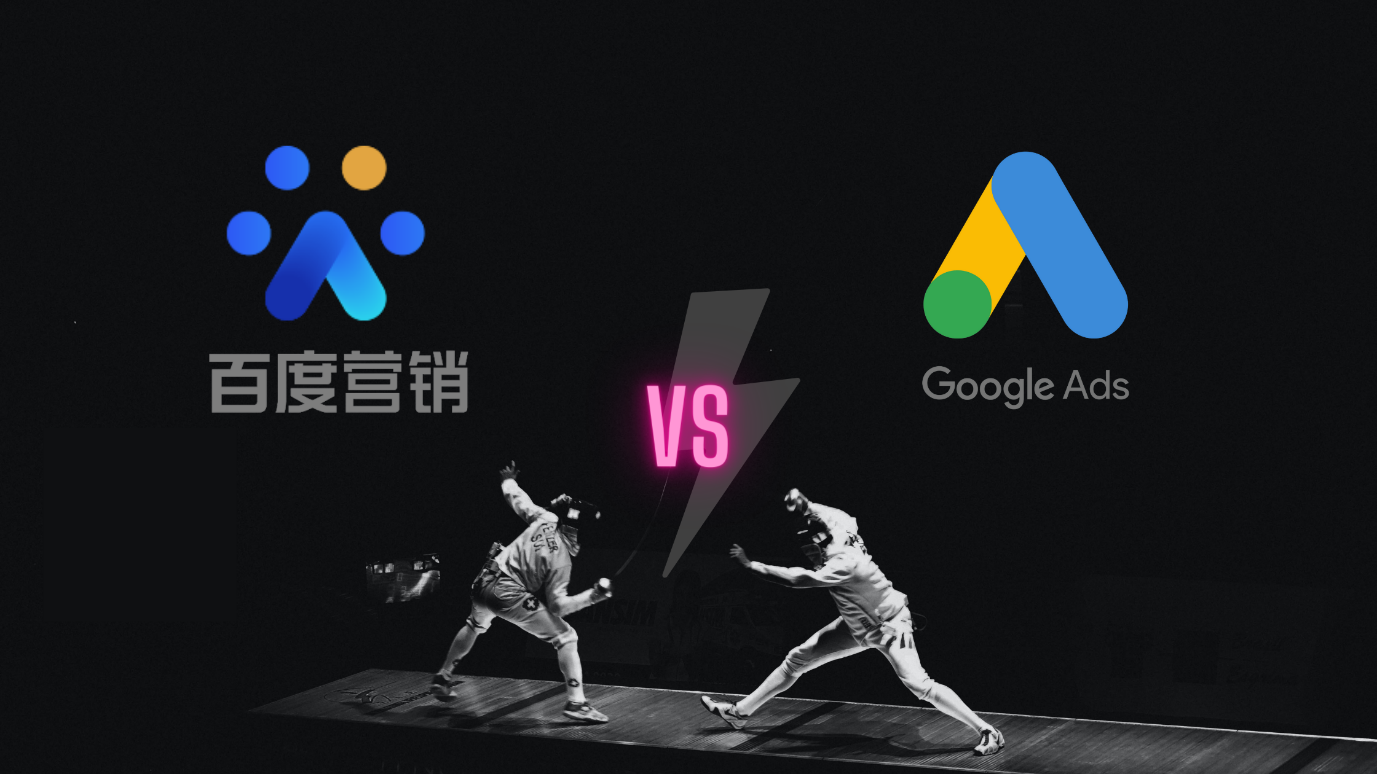
Baidu SEM (PPC) VS Google Ads: Which is Better for Your Brand
Why Baidu advertising
Most marketers know that to make their sites appear on Google’s SERPs, they must be optimised for search engines and work with content marketing to achieve the ideal result, but it takes a significant amount of time and effort.
The good news is there is an alternative to get their brand message out by paying search engines for advertising. These are the Search Engines in the market and are available for advertising: Google, Bing, Baidu, Yahoo!, Yandex, Ask, DuckDuckGo, Naver, AOL, and Dogpile, etc.
The largest search engine worldwide – Google, owns more than 90% of the market shares outside China, and advertisers could use Google Ads to target most audiences online across the globe.
However, when it comes to targeting the audiences with the largest population – China, it has not been easy using Google Ads, simply because users tend to use their local-built search engine Baidu compared to the rest.
Suppose your businesses are trying to enter markets in China; you might have noticed that the most used search engine in China is not quite the same as the rest of the world. There are 1.56% that use Google, where Baidu owns nearly 70% of the market share with 580 million monthly active users.
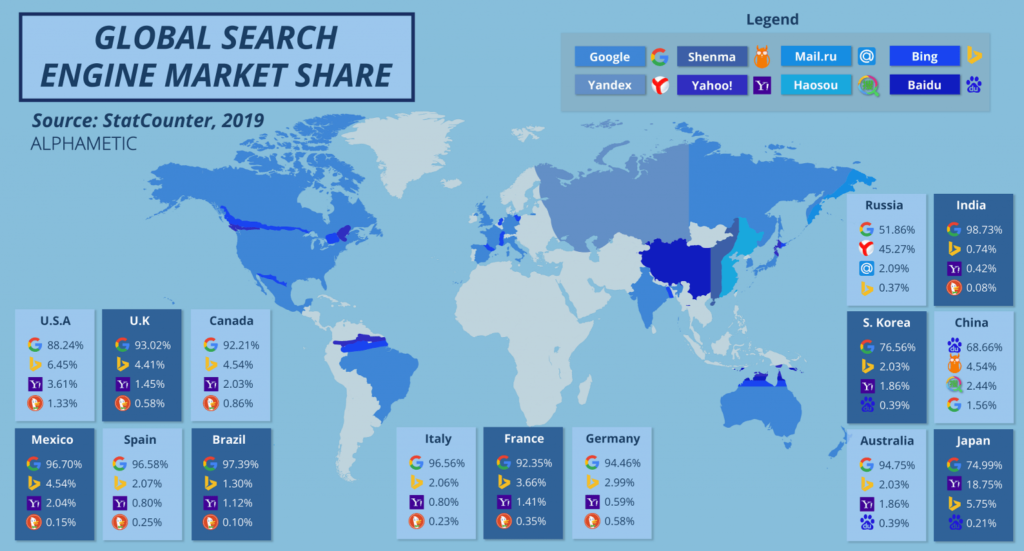
So, which search engine advertising should you invest in your brand? Whether it is Baidu SEM (PPC) or Google Ads, it depends on who you are targeting. If your business is trying to enter the market in China, then using Baidu SEM (PPC) is the appropriate way.
Baidu SEM (PPC) VS Google Ads
Baidu advertising platform is called Baidu Ying Xiao. When you enter Baidu.com or its advertising platform, the first difference you will notice is the interface language in Chinese. However, that is only the tip of the iceberg, and there are plenty of differences that matter to advertisers.
Type of ads
Google Ads offers several types of advertisements that cater to different needs of advertisers. They are the following:
- Search – Text ads on Google search results
- Display – Image ads on websites that are part of its display network or on Gmail
- Video – Video ads on YouTube
- Shopping – Product listings on Google
- App – App promotion on different channels
- Smart – Simplified, automated ads on Google and across the web
- Local – Drive customers to a physical location
- Discovery – Runs ads across Google’s feeds when they are open
In terms of Baidu PPC, these are the four ad categories offered:
- Search – Text ads on Baidu Search results
- Display – Image ads on websites that are part of its display network
- In-Feed/Native – Sponsored ads that blend with organic content
- Brand Zone – Display one brand at a time for keywords, which helps brands to dominate.
As you can see above, some of the main differences between Baidu PPC and Google Ads are that Baidu offers two other ad types that Google does not provide: In-Feed/Native ads and Brand Zone.
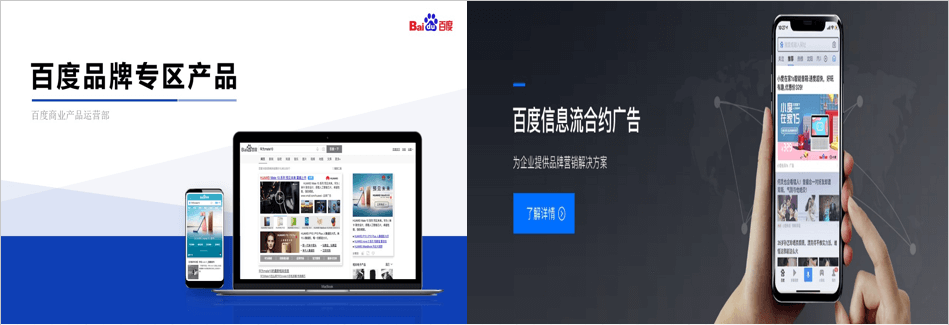
In-Feed ads
By using In-Feed ads, the ads will be on the Baidu app and browser to help boost exposure to a larger audience. The cost of using In-Feed ads will be relatively lower than Search ads and Brand Zone.
Brand Zone
Brand Zone is more appropriate for well-known brands that aim to reach mass audiences with keywords, and because the display is limited to only one brand at a time, the price will be higher than other ad types. The advantage of using Brand Zone is the ability to dominate.
Although Baidu seems to offer lesser categories in ads, the combination of pull and push ad types, brands can distribute their ads at any corner of the site.
Interface Language and culture
Another primary difference between Google Ads and Baidu PPC is the interface language. Although Google Ads serves on a global scale with different languages, users in China do not widely use the platform. Hence, the data collected by Google is not as accurate as Baidu.
Therefore, when it comes to running advertisements in Chinese, Baidu is the big winner here. It provides a better keyword research tool and accurate search results in Chinese because Baidu collects search data from its numerous Chinese-speaking users.
Google has tried to translate Chinese keywords from Hong Kong, Taiwan, Singapore, Malaysia, etc., but they speak and write Chinese differently, so it is difficult for Google to collect quality data.
Undeniably, Chinese is a complex language, so when it comes to keyword research and advertising on Baidu PPC, native Chinese speakers must do it to ensure accuracy.
Cost of Advertising
Pay-Per-Click (PPC)
Both Baidu PPC and Google Ads use Pay-Per-Click (PPC) models. In this advertising, the cost of advertising will only be on clicks instead of views. As a result, many advertisers believe it is better to measure advertising performance by Cost-Per-Click (CPC), Click-Through-Rate (CTR), Conversion rate, etc.
They measure the Cost-Per-Click (CPC)by the average cost per click on the campaigns; it highly depends on the keyword competitiveness. The keywords with higher competitiveness tend to come with higher bidding prices.
For example, these common keywords like laptop, TV, car, bed, face mask, etc., are usually used by many advertisers. Consequently, strategic keyword planning is essential for maximising advertising outcomes and minimising advertising costs.
Payment
Both Baidu PPC and Google Ads do not require any fee for account registration. However, Google Ads charge on credit, where advertisers can run ad campaigns before making any payment, and the cost will charge automatically monthly. Advertisers could also set appropriate budgets to prevent overspending.
On the other hand, Baidu PPC requires advertisers to pay upfront according to their ads budget, and depending on your location, the minimum amount is RMB 6000, which is around USD 900. Therefore, advertisers should plan their budget appropriately before running campaigns to prevent running out of budget. In addition, Baidu PPC also requires advertisers to pay a fee for account verification.
Advertising Cost
In terms of the actual cost of advertising on Baidu PPC, it is cheaper than Google Ads. According to statistics, some keywords in Baidu that target B2B users only cost around 25-40% compared to Google Ads.
Regulation
Another main difference between Google Ads and Baidu PPC is the platform regulation. Since the Chinese government has imposed strict regulations on search engines, advertisers on Baidu need to go through more legal processes than using Google Ads.
Baidu requires advertisers to provide business information. For example, certificate of incorporation of a business, business bank account statement, and other company information.
Also, certain industries like metal trading, pharmaceuticals, forex trading, etc., may need special approval. And advertisements that involve gambling, pornographic, illegal goods, politics, sensitive phrases, and words are prohibited.
Foreign advertisers must also follow an additional mandatory verification process that can take more than five days.
Keyword Strategy and Keyword Planner Tools
The first thing that all advertisers should do before running ads on search engines is to research the appropriate keywords. In general, if you have been using Google Ads for your advertising campaigns, you must be familiar with its built-in keyword research tool called Google Ads Keyword Planner.
Using a keyword planner could help advertisers identify the right keywords and receive suggestions that help target long-tail keywords.
The primary purpose of using a keyword planner is to plan and determine keyword demand, value, and competitiveness. And the most valuable keyword criteria are: High popularity, high value, low competition, and high availability.
Keyword Strategy
The first thing to learn about Baidu advertising is knowing the differences in the content structure on SERPs. Although both Baidu and Google SERPs structures are similar, the ratio of paid to organic content has a big difference.
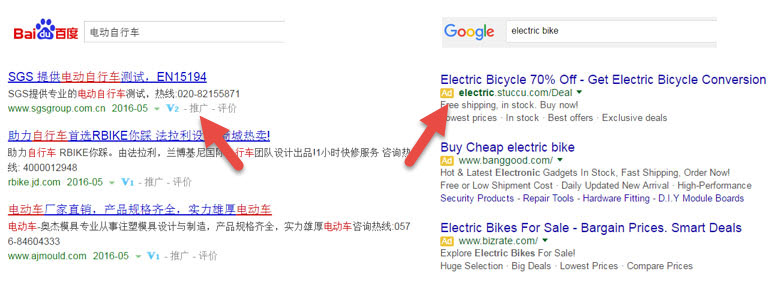
Baidu has more in favour of advertisements or paid content. The exact keyword “Marketing” in different languages is on both search engines based on our research. On Baidu SERP, ¾% of the content is advertisements highlighted in red, while for Google, it is only ¼%.
It is an advantage for advertisers because Baidu tends to show more advertisements than Google. So, when it comes to keyword planning on Baidu PPC, it is the right strategy to choose long-tail keywords to have lesser competition and cater to specific search intend.
Keyword Planner Tools
The famous keyword planner tools in the market include Google Ads keyword planner, Ubersuggest, SEMrush, AHrefs, and many more. Most advertisers should come across at least a few of them.
Although Google and other keyword research tools have been developing for Chinese keywords, they will not suggest them because Baidu’s keyword planner tools work better than other tools in Chinese keywords.
Chinese keyword research tools:
- Baidu Index –like Google Trends
- Baidu Webmaster Tools – like Google Search Console
- Baidu Keywords Planner – like Google Ads Keyword Planner
- Search Suggestion and Related Searches –like Google Search Suggestion
As you can see, the tools offered by Baidu are like what Google offers, but there are some features that an advertiser should pay attention to.
Baidu Index
Baidu Index is like Google Trends; it mainly helps advertisers learn about keyword search volume and relevancy. However, compared to Google Trends, Baidu provides better data visualisation for keyword comparison.
According to this example, we used the keyword “Car” for this search. It shows at the middle of the diagram, and the other related keywords closer to the centre indicate higher relevancy, the circle size indicates search volume, and circles in red indicate increasing search volume, and circles in blue indicate decreasing search volume.
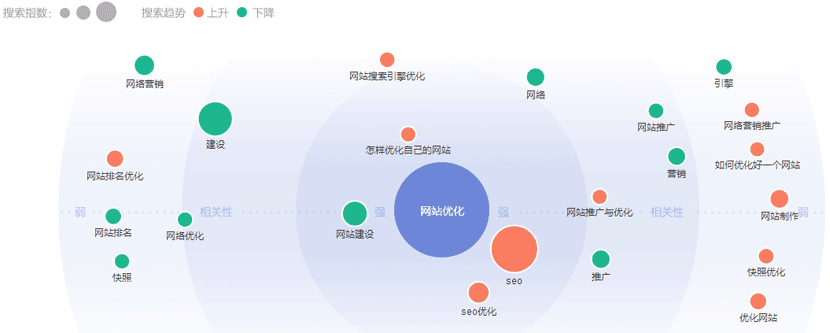
The rest of the features are like Google Trends, including the suggestions of keywords, Line graph illustrations, and demographic information, etc.
Using Baidu Index, advertisers could have a better analysis process by simultaneously viewing a more comprehensive range of relevant keywords.
Baidu Webmaster Tools
This tool is like Google Search Console. It helps advertisers to understand the keyword performance of the sites. It provides insight on keywords impression, Click-Through-Rate (CTR) and keyword ranking, etc.
These indicators play critical roles for advertisers to understand the performance of keywords and a better strategy for SEM and SEO plans.
Baidu Keyword Planner
The Baidu Keyword Planner is like Google Ads Keywords Planner. It helps advertisers plan and evaluates keywords through keyword bidding price, competition, and search volume.
It is also a built-in feature in Baidu PPC, so having a Baidu PPC account is necessary to use this feature.
These tools go together. Whether you are optimising keywords for SEO or SEM, it would help to adopt these tools for your keyword research process.
Final Words
Doing business in Chinese markets is a wise choice to grow one’s business.
In today’s tech world, the fastest way to sell and build brand awareness in China is to leverage local search engines and social media networks.
Thus, brands should start using Baidu advertising as the foundation of building a strong brand and online presence in China, along with Baidu SEO and other Chinese Social Media Networks.
| Don’t forget to share this post! |